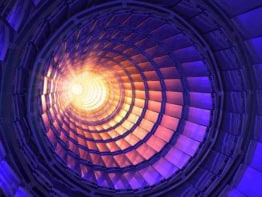A team of Russian and American physicists that discovered elements 114 and 116 in 1998 and 2000 now believe they may have created two other superheavy elements – 113 and 115. If confirmed, these results would lend even more weight to the idea of an “island of stability” at the edge of the periodic table (Y Oganessian et al. 2003 Phys. Rev. C 69 021601)
Nuclear theorists first predicted the existence of superheavy elements more than 30 years ago based on the nuclear shell model. This model, which was originally developed in 1949, explains why nuclei with certain “magic numbers” of neutrons and protons are especially stable. These nuclei have closed shells of either protons or neutrons. The most stable nuclei are “doubly magic” with closed shells of both protons and neutrons.
The heaviest known doubly magic nucleus is lead-208, which has 82 protons and 126 neutrons. The shell model predicts that the next doubly magic nucleus in the sequence will contain either 114, 120 or 126 protons and a total of 184 neutrons. Moreover, other studies predict a whole superheavy “island of stability” around these proton and neutron numbers.
In the last decade, nuclear physicists have created elements 110 (now known as darmstadtium), 111, 112, 114 and 116 – although further results are still needed before the last three are confirmed. Now, Yuri Oganessian and colleagues at the Joint Institute for Nuclear Research in Dubna, Russia – collaborating with a team from the Lawrence Livermore National Laboratory in the US – have collided calcium-48 with americium-243 nuclei to produce element 115.
Working at the Dubna lab’s U400 cyclotron, the Russian-US physicists bombarded the americium target with a beam of energetic calcium-48 nuclei day and night for a month. They observed three decay chains, which signalled the production and decay of an isotope of element 115 containing 173 neutrons, and one decay chain for an isotope of the element containing 172 neutrons. The isotopes lasted for tens of milliseconds before decaying through the emission of alpha particles to form the new element 113. This had a lifetime of 1.2 seconds before it decayed to known, lighter, elements.
Although the team is confident of its results, it agrees that the new elements will require independent confirmation before finally being accepted. The discoveries will be subject to close scrutiny, especially given the recent scandal over element 118. In 2002, the Lawrence Berkeley National Lab in the US sacked a physicist after it found that he had fabricated data purporting to show the existence of this element. Claims that the element had been discovered were subsequently withdrawn.



